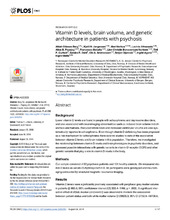| dc.contributor.author | Berg, Akiah Ottesen | en_US |
| dc.contributor.author | Jørgensen, Kjetil Nordbø | en_US |
| dc.contributor.author | Nerhus, Mari | en_US |
| dc.contributor.author | Athanasiu, Lavinia | en_US |
| dc.contributor.author | Popejoy, Alice | en_US |
| dc.contributor.author | Bettella, Francesco | en_US |
| dc.contributor.author | Norbom, Linn Christin Bonaventure | en_US |
| dc.contributor.author | Gurholt, Tiril Pedersen | en_US |
| dc.contributor.author | Dahl, Sandra Rinne | en_US |
| dc.contributor.author | Andreassen, Ole Andreas | en_US |
| dc.contributor.author | Djurovic, Srdjan | en_US |
| dc.contributor.author | Agartz, Ingrid | en_US |
| dc.contributor.author | Melle, Ingrid | en_US |
| dc.date.accessioned | 2019-06-19T10:46:02Z | |
| dc.date.available | 2019-06-19T10:46:02Z | |
| dc.date.issued | 2018-08-24 | |
| dc.Published | Berg AO, Jørgensen Kn, Nerhus M, Athanasiu L, Popejoy A, Bettella F, Norbom L, Gurholt TP, Dahl S, Andreassen OA, Djurovic S, Agartz I, Melle I. Vitamin D levels, brain volume, and genetic architecture in patients with psychosis. PLoS ONE. 2018;13(8):e0200250 | eng |
| dc.identifier.issn | 1932-6203 | |
| dc.identifier.uri | https://hdl.handle.net/1956/20235 | |
| dc.description.abstract | Background: Lower vitamin D levels are found in people with schizophrenia and depressive disorders, and also associated with neuroimaging abnormalities such as reduced brain volume in both animals and humans. Reduced whole brain and increased ventricular volume are also systematically reported in schizophrenia. Even though vitamin D deficiency has been proposed as a risk mechanism for schizophrenia there exist no studies to date of the association between vitamin D levels and brain volume in this population. Therefore, we investigated the relationship between vitamin D levels and brain phenotypes in psychotic disorders, and assessed possible interactions with genetic variants in vitamin D receptor (VDR) and other genetic variants that play a role in vitamin D levels in the body. Methods: Our sample consisted of 83 psychosis patients and 101 healthy controls. We measured vitamin D levels as serum 25-hydroxyvitamin D. All participants were genotyped and neuroimaging conducted by structural magnetic resonance imaging. Results: Vitamin D levels were significantly positively associated with peripheral grey matter volume in patients (β 860.6; 95% confidence interval (CI) 333.4–1466, p < .003). A significant interaction effect of BSML marker (rs1544410) was observed to mediate the association between patient status and both white matter volume (β 23603.3; 95% CI 2732.8–48708.6, p < .05) and whole brain volume (β 46670.6, 95% CI 8817.8–93888.3, p < .04). Vitamin D did not predict ventricular volume, which rather was associated with patient status (β 4423.3, 95% CI 1583.2–7267.8p < .002) and CYP24A1 marker (rs6013897) (β 2491.5, 95% CI 269.7–4978.5, p < .04). Conclusions: This is the first study of the association between vitamin D levels and brain volume in patients with psychotic disorders that takes into account possible interaction with genetic polymorphisms. The present findings warrant replication in independent samples. | en_US |
| dc.language.iso | eng | eng |
| dc.publisher | PLOS | eng |
| dc.rights | Attribution CC BY | eng |
| dc.rights.uri | http://creativecommons.org/licenses/by/4.0 | eng |
| dc.title | Vitamin D levels, brain volume, and genetic architecture in patients with psychosis | en_US |
| dc.type | Peer reviewed | |
| dc.type | Journal article | |
| dc.date.updated | 2019-01-30T10:29:34Z | |
| dc.description.version | publishedVersion | en_US |
| dc.rights.holder | Copyright 2018 The Author(s) | |
| dc.identifier.doi | https://doi.org/10.1371/journal.pone.0200250 | |
| dc.identifier.cristin | 1610754 | |
| dc.source.journal | PLoS ONE | |

